#allium cernuum
Text

Allium cernuum in bloom now
28 notes
·
View notes
Text
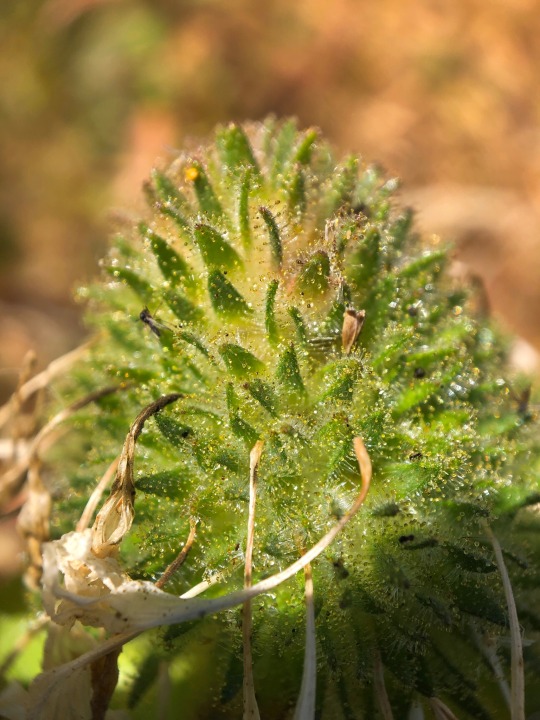

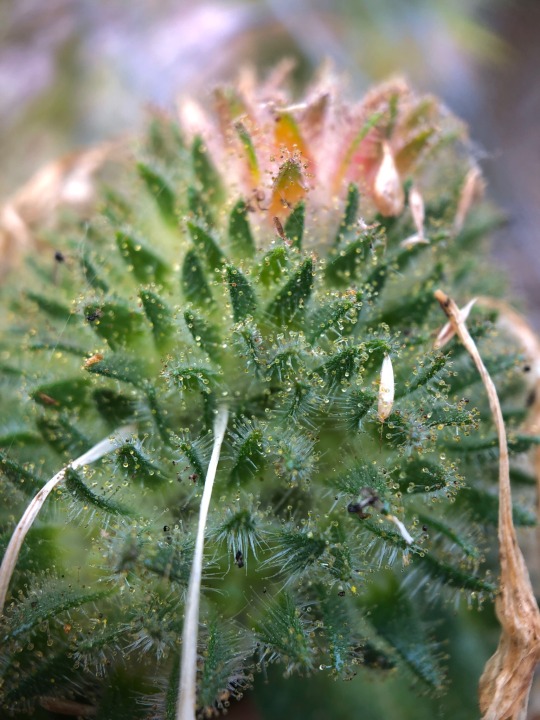

0 notes
Text
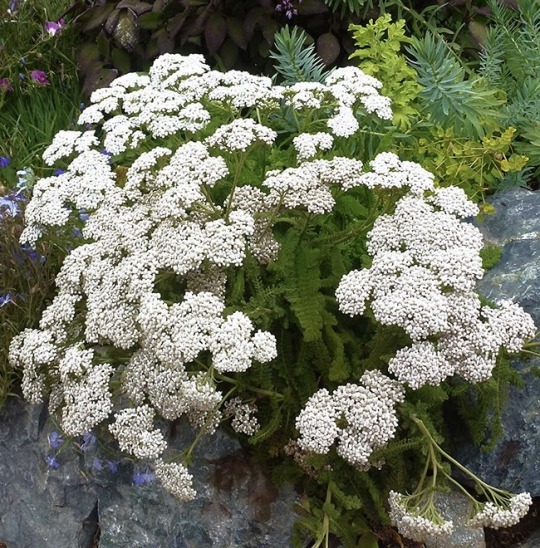




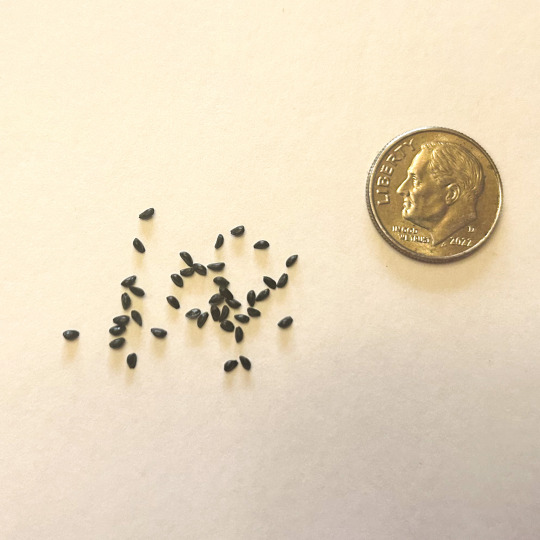
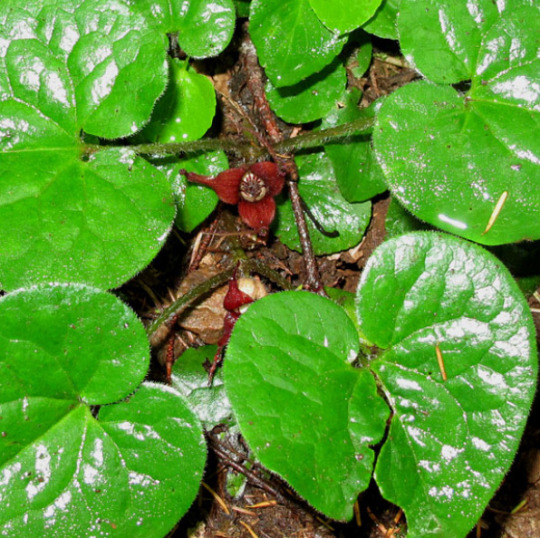

White Yarrow/“Milfoil”
achillea millefolium
Nodding Wild Onion/“Lady Leek”
allium cernuum
Wild Columbines/“Granny’s Bonnets”
aquilegia canadensis
Wild Ginger
asarum canadense
7 notes
·
View notes
Text

nodding onion (Allium cernuum)
28 notes
·
View notes
Text
Dug out one of the areas the Canada goldenrod had planted itself in, which is a very bad spot for such an aggressive plant. Ended up with like an armload of rhizomes. Took one piece and transplanted it to the area I had initially planned for that species, but the one I ordered ended up being an aster of unknown species. I cut the shoots off the rest and will be eating them. Still have to grab the rest growing in the other area. Got all the weeds and garbage out of the front, and cut off and chopped of the dead bits. These will disappear as birds and squirrels take them to build their nests, but for now it’s a natural mulch. I didn’t have time for the side or the back, but I’ll do the side at least tomorrow. I did however take look through to see what’s coming up!
And so far, of the 172 plants I have planted (and I have 72 more on the way, starting mid-May!), the following are showing signs of life or even leafing out:
*EDITED TO ADD THOSE I NOTICED TODAY (DAY AFTER POSTING)*
001. Achillea millefolium (yarrow) 3rd year!
002. Adiantum pedatum (maidenhair fern) Survived its first winter into 2nd year!
003. Agastache foeniculum (anise hyssop) 4th year!
004. Agastache scrophulariifolia (purple giant hyssop) Survived its first winter into 2nd year!
005. Allium canadense (Canada garlic) 5th year!
006. Allium cernuum (nodding onion) 5th year!
007. Allium schoenoprasum (chives) 4th year!
008. Allium stellatum (pink onion) Survived its first winter into 2nd year!
009. Allium tricoccum (ramps) 3rd year!
010. Amelanchier canadensis (Canadian serviceberry) 4th year! But still too young for fruit.
011. Anaphalis margaritacea (pearly everlasting) 5th year!
012. Andromeda polifolia (bog rosemary) Survived its first winter into 2nd year!
013. Aquilegia brevistyla (smallflower columbine) 4th year!
014. Aquilegia canadensis (eastern red columbine) 5th year!
015. Arabis alpina (alpine rockcress) Survived its first winter into 2nd year! The first one I attempted was extremely root-bound coming out the pot and sadly did not survive the winter, but this one did!
016. Argentina anserina (silverweed) Survived its first winter into 2nd year!
017. Armeria maritima (Thrift seapink) 3rd year!
018. Aronia melanocarpa (black chokeberry) 3rd year! But still too young for fruit.
019. Artemisia ludoviciana (white sage) 3rd year! It was supposed to be A. frigida, but...it’s not. lol Thankfully it’s not too aggressive so far.
020. Aruncus dioicus (bride’s feathers) 3rd year!
021. Asarum canadense (Canada ginger) 4th year!
022. Asclepias incarnata (swamp milkweed) 4th year!
023. Asclepias sullivanti (prairie milkweed) Survived its first winter into 2nd year!
024. Asclepias syriaca (common milkweed) 3rd year!
025. Asimina triloba (pawpaw) 5th year! But still too young for fruit.
026. Asplenium trichomanes (maidenhair spleenwort) 3rd year!
027. Athyrium felix-femina (lady fern) 3rd year!
028. Caltha palustris (marsh marigold) 3rd year!
029. Campanula rotundifolia (harebell) 5th year!
030. Cardamine concenata (cutleaf toothwort) Came out of dormancy for it’s 1st year!
031. Castilleja miniata (giant red paintbrush) Survived its first winter into 2nd year! It’s a parasitic plant, so I planted it at the stone line so it could feed off the grass, and close to the sunchokes so it can feed off them too, plus there are cedar roots from the trees by the well, and I’ve just transplanted Canada goldenrod nearby so I think it will be okay!
032. Ceanothus americanus (New Jersey tea) 3rd year!
033. Cerastium arvense (field chickweed) 4th year!
034. Cercis canadensis (eastern redbud) 4th year! But still too young for flowers.
035. Clinopodium arkansanum (wild savoury) Survived its first winter into 2nd year!
036. Comptonia peregrina (Sweetfern) Survived its first winter into 2nd year!
037. Coreopsis lanceolata (lance-leaved tickseed) 3rd year!
038. Cornus canadensis (bunchberry) Survived its first winter into 2nd year! The squirrels did not dig it up this time!
039. Cornus florida (flowering dogwood) 3rd year! But still too young for flowers.
040. Cystopteris bulbifera (berry bladder fern) 3rd year!
041. Dalea purpurea (purple prairie clover)
042. Drymocallis arguta (prairie cinquefoil) Survived its first winter into 2nd year!
043. Echinacea purpurea (purple coneflower) 5th year!
044. Erigeron glabellus var. pubescens (streamside fleabane) Survived its first winter into 2nd year! I put it in a very narrow ugly side area. Should help to pretty it up along with black-eyed susan and whatever else I think will go nicely there.
045. Erythronium americanum (trout lily) 3rd year! And not only that but despite not flowering and my not seeing any dropper stems last year, the thing has somehow spread itself. I have no idea how I missed the number of droppers that would have been necessary to make this happen but I’m not complaining. Be nice if one of them flowered this year though.
046. Eupatorium purpureum (sweet Joe Pye weed) Survived its first winter into 2nd year!
047. Fragaria vesca (woodland strawberry) 3rd year! Mine has white strawberries. Apparently that can happen with this species. Still taste like strawberries. I hope it makes lots this year.
048. Fragaria virginiana (Virginia strawberry) 3rd year! Would be awesome if it made more than flowers this year though.
049. Galium boreale (northern bedstraw) Survived its first winter into 2nd year! My first attempt died. Probably because it was potted too long and planted too late.
050. Gaultheria procumbens (American wintergreen) 4th year! It’s not doing the greatest, likely due to how root-bound it was when I got it, but it’s been hanging on. I’m getting it a friend this year, so hopefully that will help.
051. Geranium maculatum (wild geranium) 4th year!
052. Geranium robertianum (herb Robert) Survived its first winter into 2nd year!
053. Geum aleppicum (yellow avens) 4th year at least! I don’t know for sure, because it was already here when I moved in. It’s native so it gets to stay.
054. Geum canadense (white avens) 4th year at least! I don’t know for sure, because it was already here when I moved in. It’s native so it gets to stay.
055. Geum rivale (purple avens) Survived its first winter into 2nd year!
056. Geum triflorum (prairie smoke) 5th year!
057. Grindelia squarrosa (curly cup gumweed) Survived its first winter into 2nd year!
058. Helianthus nuttallii (common tall sunflower) 4th year!
059. Heliopsis helianthoides (false sunflower) 3rd year!
060. Heuchera richardsonii (prairie alumroot) Survived its first winter into 2nd year!
061. Hibiscus moscheutos (swamp rose mallow) 4th year! And coming up early this year, too!
062. Hierochloe odorata (sweetgrass) 5th year! It flowered two years ago. I hope it does again this year.
063. Humulus lupulus (Hop) 3rd year! The current shoots are likely to die though Last year I swear they died five times before it finally took off but eventually it did and had a whole growing year. I expect the same this year.
064. Hydrophyllum virginianum (Virginia waterleaf) Survived its first winter into 2nd year!
065. Juglans nigra (black walnut) Likely somewhere around 150 years old, judging by the size. I obviously didn’t plant it, but it is on the property so it’s mine while I live here.
066. Juniperus horizontalis (creeping juniper) Survived its first winter into 2nd year!
067. Liatris spicata (dense blazing star) Survived its first winter into 2nd year!
068. Lilium michiganense (Michigan lily) 4th year!
069. Lindera benzoin (spicebush) 5th year and flowering!
070. Linum lewisii (blue flax) Survived its first winter into 2nd year!
071. Lysimachia ciliolata (fringed loosestrife) Survived its first winter into 2nd year!
072. Mahonia repens (creeping Oregon grape) 3rd year!
073. Maianthemum stellata (starry false Solomon’s seal) 3rd year!
074. Mentha arvensis (wild mint) 4th year!
075. Menyanthes trifoliata (bog bean) Survived its first winter into 2nd year!
076. Mertensia paniculata (tall bluebells) 4th year!
077. Mertensia virginica (Virginia bluebells) 3rd year!
078. Monarda fistulosa (wild bergamot) 5th year!
079. Monarda punctata (spotted beebalm) 3rd year! And coming in much quicker than last year.
080. Oenothera biennis (evening primrose) Seeded! I had thought my previous plant’s seeds hadn’t taken when no new plants had come up that year, but there are a couple this year close to the area I had it in, so it looks to have successfully reseeded itself after all!
081. Oenothera fruticosa (narrow-leaved sundrops) Survived its first winter into 2nd year! And this species is perennial rather than biennial like its cousin.
082. Oligoneuron rigida (Stiff goldenrod) Survived its first winter into 2nd year!
083. Onoclea sensibilis (Sensitive fern) 3rd year! I’m hoping the meadow sundrops, cup plant, and zigzag goldenrod will help shield it this year. They like part sun/part shade, but the past couple summers were still pretty hard on it.
084. Opuntia fragilis (fragile prickly pear) 4th year! The spring rains are always hard on it, though, and it takes at least a couple weeks in the heat of late spring to recover, so I don’t think it will produce fruit any time soon, certainly not this year.
085. Opuntia humifusa (eastern prickly pear) 3rd year! It did not like this winter though (took the one before it like a champ, though), but it’s showing signs of recovery.
086. Osmundastrum cinnamomea (cinnamon fern) Survived its first winter into 2nd year!
087. Oxalis stricta (yellow wood sorrel) Successfully reseeded! I mean, it basically grows as a weed, so it’s quite prolific. Doesn’t really have an effect on surrounding plants, though, and it’s delicate, so it’s good to have a ton of them if you want to cook desserts or make jams or something with them. They are deliciously tart.
088. Parthenocissus quinquefolia (Virginia creeper) 4th year! Might be older though. It was tiny when I got here (much bigger now!) but I didn’t plant it so I couldn’t judge its years based on size.
089. Phlox divaricata (woodland phlox) 3rd year!
090. Polygonatum biflorum (smooth Solomon’s seal) Survived its first winter into 2nd year!
091. Polystichum acrostichoides (Christmas fern) 3rd year!
092. Prunella vulgaris (common selfheal) I didn’t plant it so I don’t know how long it’s been here. We’ll call it year 5, but it is native and a pretty little thing, with edible and medicinal uses.
093. Prunus nigra (Canada plum) 3rd year! But still too young for fruit.
094. Prunus pumila (sand cherry) Survived its first winter into 2nd year!
095. Prunus serotina (black cherry) 4th year! But still too young for fruit.
096. Pycnanthemum tenuifolium (slender mountain mint) 4th year!
097. Pycnanthemum virginianum (Virginia mountain mint) 4th year!
098. Rhus aromatica (fragrant sumac) 5th year!
099. Rosa blanda (smooth rose) 4th year! Maybe it will bloom this year.
100. Rubus occidentalis (black raspberry) 5th year! This was supposed to be R. strigosus but...I discovered otherwise when the berries turned black instead of remaining red. lol
101. Rubus strigosus (American red raspberry) Survived its first winter into 2nd year! And is hopefully actually R. strigosus this time. lol Pretty sure it’s not R. occidentalis again, though, because it’s much more aggressive.
102. Sambucus canadensis (common elderberry) 5th year! Hopefully this year it makes more berries and they don’t all fall off before turning ripe this time.
103. Silphium perfoliatum (cup plant) Survived its first winter into 2nd year!
104. Sisyrinchium montanum (blue-eyed grass) Survived its first winter into 2nd year!
105. Solidago canadensis (Canada goldenrod) This is its 3rd year since planting itself! We’ll see how it likes the new area I put it in.
106. Solidago flexicaulis (zigzag goldenrod) 3rd year since planting itself!
107. Solidago nemoralis (grey goldenrod) 3rd year!
108. Solidago simplex (spike goldenrod) Survived its first winter into 2nd year! First one I tried died. Maybe wasn’t getting enough sunlight.
109. Spiraea alba (white meadowsweet) 5th year!
110. Sporobolus heterolepis (prairie dropseed) Survived its first winter into 2nd year!
111. Symphoricarpos occidentalis (western snowberry) Survived its first winter into 2nd year!
112. Symphoricarpos orbiculatus (coralberry) Survived its first winter into 2nd year!
113. Symphyotrichum ciliolatum (fringed blue aster) 4th year!
114. Symphyotrichum laeve (smooth aster) 4th year! And spreading where it shouldn’t. Going to try eating the shoots.
115. Symphyotrichum lanceolatum (panicled aster) 4th year! And I’m going to have to do something about those shoots too because that’s getting a little crazy.
116. Symphyotrichum novae-angliae (New England aster) 3rd year!
117. Thalictrum pubescens (tall meadow-rue)
118. Thuja occidentalis (eastern white cedar) Likely around 20 years old or so. There’s a row of them next to a wall. Mine while I live here.
119. Tradescantia ohiensis (Ohio spiderwort) Survived its first winter into 2nd year!
120. Trillium erectum (red trillium) Survived its first winter into 2nd year!
121. Trillium flexipes (nodding wake-robin) 3rd year!
122. Trillium grandiflorum (great white trillium) Survived its first winter into 2nd year!
123. Urtica gracilis (stinging nettle) 4th year since it planted itself in my garden at the old place and I took it with me to the new place!
124. Vaccinium angustifolium (lowbush blueberry) 5th year! Not doing well, though. I have to figure out a different spot for it.
125. Vaccinium corymbosom (northern highbush blueberry) 5th year! Last year I had to transplant it because it did not like the spot it was in. Hopefully it does better in its new home.
126. Verbena hastata (blue vervain) 3rd year!
127. Verbena stricta (hoary vervain) Survived its first winter into 2nd year!
128. Viburnum lentago (nannyberry) 4th year! But still too young for fruit.
129. Viburnum nudum cassinoides (witherod viburnum) 4th year! But still too young for fruit.
130. Viola blanda (sweet white violet) 4th year!
131. Viola canadensis (Canada violet) 4th year!
132. Viola labradorica (Labrador violet) Survived its first winter into 2nd year!
133. Viola nephrophylla (northern bog violet) Survived its first winter into 2nd year!
134. Viola palustris (marsh violet) Survived its first winter into 2nd year!
135. Vitis riparia (riverbank grape) 3rd year!
136. Waldsteinia fragarioides (barren strawberry) Survived its first winter into 2nd year!
137. Zizia aptera (heart-leaved alexanders) Survived its first winter into 2nd year!
138. Zizia aurea (golden alexanders) 4th year!
So most but it’s still early and I wasn’t looking super hard in the side and front areas, so we’ll see how many more will join us this year.
9 notes
·
View notes
Text
Witch’s Herbal Entry: Alliums
Allium spp.

(Above: an ornamental allium, probably A. cernuum, nodding onion, native to North America.)
Common Names: (A. cepa) Onion, Scallion, Shallots, (A. sativum) Garlic , (A. schoenoprasum) Chives, (A. ampeloprasum) Leek
Type: mostly bienniel; those for vegetable consumption are grown as annuals, and some varieties (mostly ornamentals) are perennial
Element: Fire
Astrological: Mars
Magical Uses: protection, exorcism, health & healing, lust
Botanical Family: Amaryllidaceae
Region of Origin: unclear due to extremely wide and early distribution, but probably Central Asia; chives are native throughout the northern hemisphere
Allium is simply the Latin name referring to garlic or onions.
Growth and Care
By and large, Allium are very easy to grow. They are part of the Amaryllis family and the largest genus within it--there are a slew of species both ornamental and culinary that simply can’t be covered in a single entry. The sulfur content that gives every Allium its distinct taste and fragrance is a deterrent to many garden pests, including deer, rabbits, squirrels and chipmunks. They tend to be toxic to animals (dogs and cats especially), but all varieties, including the ornamental category, are edible by humans. They are one of the earliest plants cultivated by man.
Sizes range anywhere from 2 inches to up to 4 feet in height depending on species and cultivar. Almost all types considered for garden use require full sun and well drained soil--if you’re growing onions, garlic, or anything that you’re going to harvest the bulb of, be sure that the soil is well-worked and loose. Dense, compacted soil can affect bulb development. They are generally pretty drought tolerant and even more so if mulched. If planting as a vegetable crop, mixing in some composted manure at planting time is a good step to take, as is crop rotation if you grow yearly, as they can be very demanding of nitrogen. The seeds tend to have a short shelf life, so many people, myself included, plant using bulbs or sets. Since most vegetable-type Allium are biennials, if left to their second year, they will bloom, which is really only recommended if you want to harvest seed for the next season. Just as with many herbs and vegetables, once the plant blooms, the chemical changes that occur change its flavor, often adversely.
Not all varieties bloom, but when they do, it is generally in a clustered globe of purplish flowers, sometimes shifting to true pink or blue, with the odd yellow flowering variety in for good measure. Most of the Allium selected for ornamental use are perennial bulbs that will last years in the garden, with large, whimsical pompoms. The flowerheads dry very nicely for decorative use. If you’re interested in bringing Allium into your garden for strictly ornamental use, as always, I recommend looking for species native to your region first, and there are certainly some great choices native to North America.
Not without their pests and problems, Allium of all kinds can fall prey to thrips, onion maggots, slugs, and the newly invasive allium leafminer. In persistent damp weather, leaf rot and mildew problems may arise. Good air circulation in the planting area can help combat this.
General Use
Food! Onions form a foundation often paired with two other vegetables to form the aromatic base of many forms of cooking. Coupled with celery and bell pepper, they form the “Holy Trinity” that is at the root of Cajun and Creole food. In French cuisine, mirepoix made up of onions, carrot and celery cooked in butter creates a similar flavor base, with its sister duxelles, which is mushrooms and herbs paired with shallots or onions, reduced to a paste. We see this pattern again and again in Italian and Spanish soffrittos, Portugese refogado, in Indian and Chinese cooking, and variations in German and Polish food that prefer leeks used in the same manner. Alliums are probably in the background of almost every soup, stew or curry that you’ve ever eaten.
One of my newest favorite ingredients is green garlic--I started growing garlic for myself in the past couple of years and in a moment of need, cut the garlic greens to use in place of scallion in a dish. I didn’t know it at the time, but garlic greens and scapes (the non-flowering stem that mature garlic puts up) are absolutely delicious and a vegetable delicacy that you should give a try. For chives, both greens and blossoms are used culinarily, but vinegar infused with chive blossoms is a delicate and flavorful ingredient. The process of making it is exceptionally pretty (and potentially magical), yielding a blushy pink end product with a light onion flavor.
As a group, Allium are good source of fiber, phosphorus, manganese, folate, copper, sulfur and B vitamins. They are low in calories, contain antioxidants and compounds that help adjust healthy cholesterol levels, so can be an inexpensive and very healthful way to add flavor to food.
Allium are found in a wealth of home remedies, having a reputation for generally boosting the immune system, as well as treating coughs and chest colds. Garlic is widely publicized in this regard, having documented anti-fungal, antiviral and antibacterial properties, making it an important component in that old standby, four thieves vinegar. Onions follow up next in texts on using Allium for health. The raw juice of an onion is mixed with honey and used much like cough syrup, as recorded by Nicholas Culpepper--fresh onion juice is also coupled with peppermint tea in some places to help quiet severe vomiting. Raw onions or garlic can also be used as a poultice for small cuts and infected areas, either a fresh slice pressed against the affected area or mashed into a poultice, and anecdotally removes splinters and beestings. A practice of putting onions in one’s socks (sliced, so that the sliced side is flush against the bottom of one’s foot) while you sleep is said to draw toxins out of the body and help in recovery from illness, which seems to come from either Ayurvedic or Traditional Chinese medicine. There is no documented scientific reason why this should work, though it may absorb and combat bacteria that are specifically on your feet. Others place sliced onions near the bedside to absorb bacteria and viruses in the air.
(Below: garlic, freshly harvested from my garden in June. Smaller than hoped, but better than the previous year.)
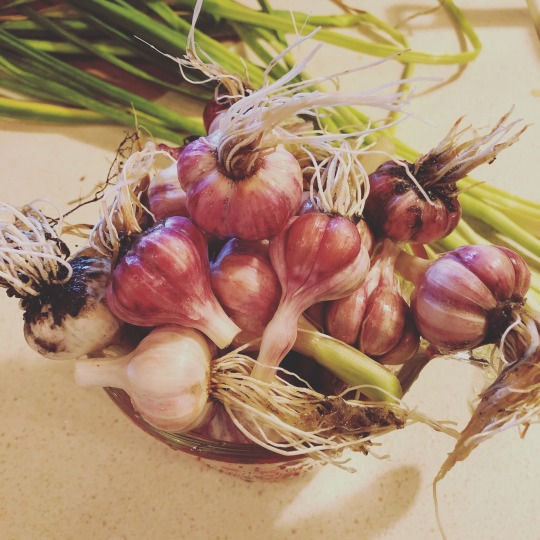
Magical and Symbolic Use
Onions, having become such a foundational food in human cuisine the world over, unsurprisingly have a place in many other cultural niches. In ancient Egypt, onions were used as a charm to protect children from ghosts and spirits as well in burial rites. Traces of onion have been found in the mummified eyesockets of Ramesses IV. It’s believed that the concentric rings of flesh in the bulb was a reference to eternal life for these people, and associated with the goddess Isis. As noted earlier, allium flowers tend to dry very well, and perhaps could make a lovely offering or decoration for the altar if you revere Isis or have a need to call on her.
Onions and garlic were also lauded by the Greeks and the Arabs as granting endurance and stamina, and to stimulate sexual desire due to their “hot” nature. Halving or quartering an onion and placing it in the corners of the kitchen or the house are a standard cleansing and protection technique, usually replaced and renewed every week or two.
You may also consider growing onions in your garden or even potted in your kitchen to bring protection in the home, or add the dried flowers into sachets. If you use scallions or “green onions” (any one of several A. cepa varieties that have a mild flavor and are either harvested prior to or don’t develop the rounded bulb we think of as an onion may be used as scallions) in your cooking, taking the white root ends from a standard grocery store purchase and let them sit in a half inch of water on a sunny windowsill. In short order, they’ll send up new greens to be harvested over and over again. If planted in soil, the size and vigor to which they grow to may surprise you--if you want to keep things petite and in the kitchen, opt for chives.
#witch#witchcraft#herbal#herbalism#pagan#neopagan#wicca#wiccan#nonwiccan#book of shadows#grimoire#american witch's herbal
3 notes
·
View notes
Text
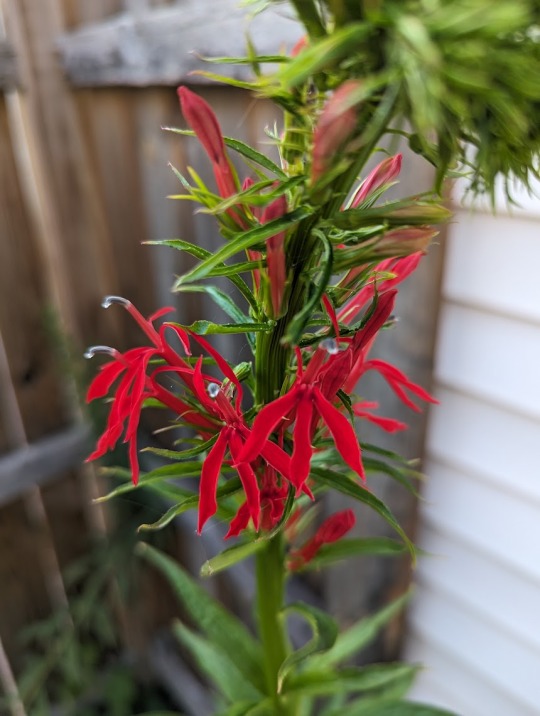



Garden update 7/28:
Lobelia Cardinalis is finally starting to bloom: been excited for this one, it's grown to twice the size that sources claim it would and looks like it will be blooming for a while.
Liatris Spicata started blooming about a week ago, Seuss ass looking plant. Pollinators really like it, been seeing a lot of leafcutters on it.
Allium Cernuum (nodding onion) also opened just the other day
Bonus weevil.
1 note
·
View note
Photo

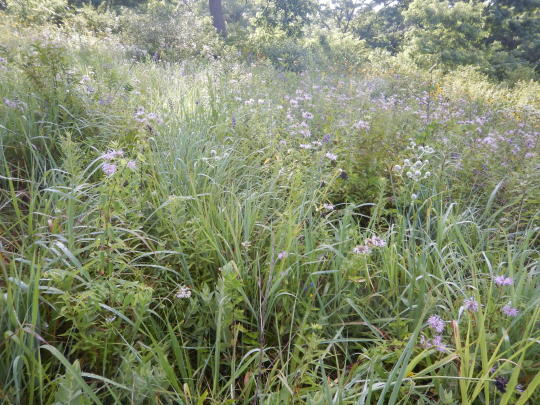
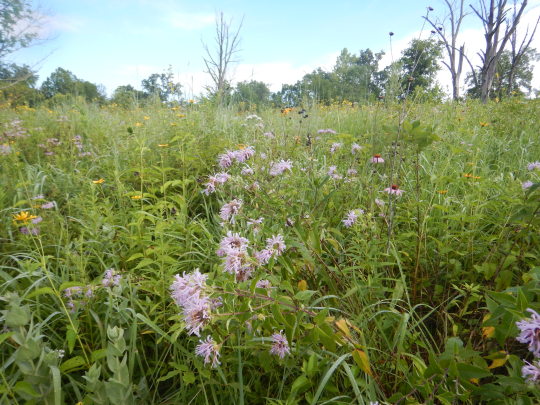
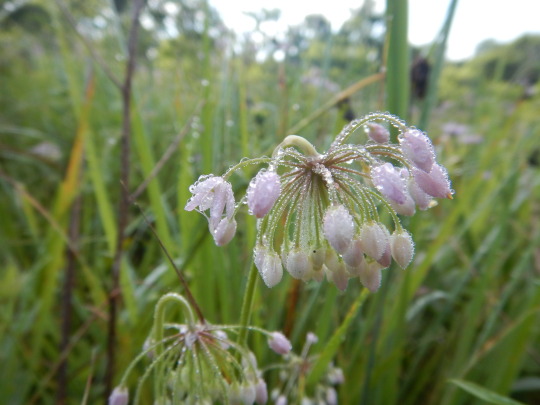
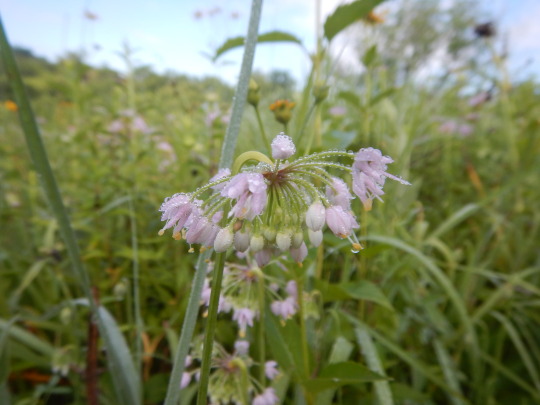


Small splotches of electric blue dot the prairie from a glance, Delphinium exaltatum, state threatened in Ohio; around them some Allium cernuum and Pycnanthemum virginianum mixed in with the Eryngium yuccifolium and the Monarda fistulosa.
Many species with white flowers attract more wasps then they do bees. These wasps are critical for ecosystem health and offering a predatory level to the food webs. Many bees and skippers seem to be more favorable of pink flowering species, while this is highly simplified information understanding this gives a person an idea of what insects and at what level of abundance they are present. Similarly with blue flowers many bees are attracted to them, Delphinium exaltatum is also know for attracting humming birds, hawkmoths, clearwings, and large butterflies and skippers.
#allium#allium cernuum#pycnanthemum#pycnanthemum virginianum#Eryngium yuccifolium#eryngium#monarda#monarda fistulosa#ohio#wildflowers#plantblr#botany#cottagecore#Delphinium#delphinum exaltatum
65 notes
·
View notes
Photo

Nodding Onioin (Allium cernuum)
Pleasant Valley, WI, 9-4-17
#nodding onion#allium cernuum#flower#wildlflower#original photographers#photographers on tumblr#nature photography
8 notes
·
View notes
Photo





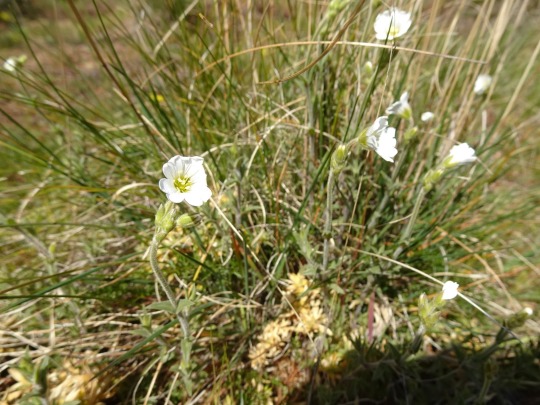
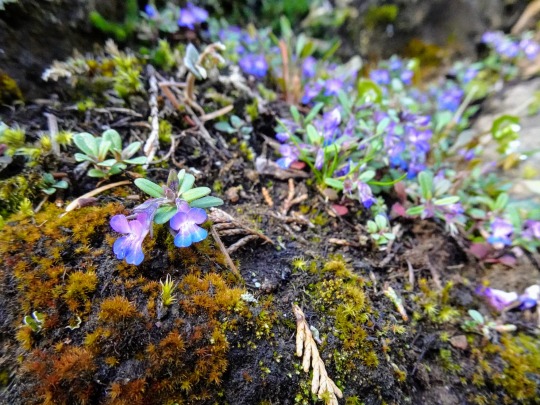
The wildflowers are spectacular this time of year at Washington Park near Anacortes, WA! The Samish Nation used to go here collect plants like common camas, Camassia quamash, and nodding onions, Allium cernuum. The hills used to be just purple with wildflowers, but misuse by Europeans, followed by modern tourist activity, compacted the soil and killed a lot of the wildflowers. I’m one of those modern tourists, but I tried to be careful and stay on the trail to protect the remaining flowers. Flowers pictured here are: Calypso bulbosa (calypso orchid), Ribes sanguineum (red flowering currant), Plectritis congesta and Lomatium utriculatum (sea blush and spring gold), Lithophragma parviflorum (small-flowered prairie star), Cerastium arvense (field chickweed), and Collinsia parviflora (small-flowered blue-eyed Molly).
#wildflowers#puget sound#anacortes#washington park#Samish Nation land#plants of washington state#botany
42 notes
·
View notes
Text

Nodding Onion, allium cernuum
Flowers usually bloom July-August. Edible, with a strong onion flavor.
#photography#my photos#wildflowers#nodding onion#plants#botany#edible plants#foraging#cottagecore#colorado#flowers#nature
5 notes
·
View notes
Text
Nodding Onion

Scientific Name: Allium cernuum
Perennial; 12-20”; full sun, part shade; sand, gravelly, loam, or clay soil; drought tolerant
Description: Nodding onion is a native plant found in the Rocky Mountains and cooler regions of the South. It is also widely distributed across the northern United States. Plants have a characteristic onion odor and their narrow, grass-like leaves grow from a single bulb. Each flower stalk bears an umbel of pink flowers that hang down like a shepherd’s crook. The species name cernuum comes from the Latin word for “nodding.”
Nodding onion plants are an attractive choice for native or rock gardens and are quite easy to grow. Their lovely pink to purple umbels, flowering in early to mid-summer, provide interest in clumps near other low growing plants such as wild geranium, prairie phlox, Missouri evening primrose and daisies. Interplanting with a groundcover also disguises fading foliage which dries out after blooming.
Native Americans and early settlers ate nodding onions for food and used them for medicinal purposes. Plants were steamed for immediate consumption or dried for use in the winter. They are still eaten by people who forage for edible plants. All parts may be eaten, but their flavor is stronger than commercial onions. Collecting in the wild before flowering is not recommended as plants can easily be mistaken for poisonous death camas.
Height: Up to 20” tall
Spread/Spacing: 3 – 6” / plant 12” apart
Exposure: Full sun, part shade; Flower best in full sun, but benefit from some light afternoon shade in hot locations.
Soil Tolerances: sand, gravel, loam, clay; Does fine in average well-drained soil. Tolerates shallow, rocky soil.
Soil Moisture: Dry to moist
Water: Low to medium; drought tolerant
Bloom: June - August; pink
Value to Pollinators: Attractive to hummingbirds, butterflies, native bees, and honeybees. Host to the hairstreak butterfly caterpillar.
Deer & Rabbit Resistance: Deer resistant. Some sources also report they are rabbit resistant. Bears and squirrels will sometimes eat the bulbs.
Where they like to grow: Rocky soil, open woods, meadows, prairies
Cultivation Notes: Very easy to grow from either seeds or bulbs. Plant seeds in the fall after scarifying. Nodding onion plants self-seed readily. To prevent spreading, deadhead before seeds develop. Bulbs form bulblets that should be divided every 3 years.
Photo Credit: Jane Thomson
1 note
·
View note
Photo

KPM24066 Allium cernuum by kenmines64 https://flic.kr/p/N68tCm
3 notes
·
View notes
Text
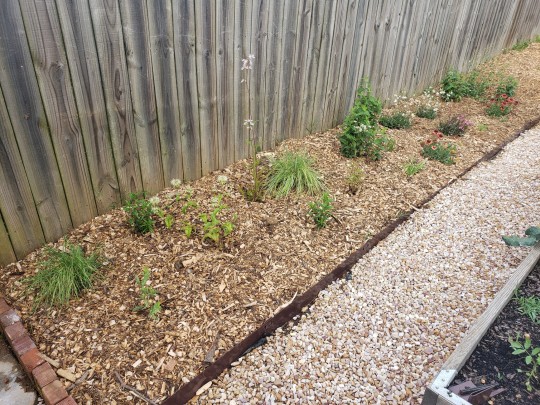
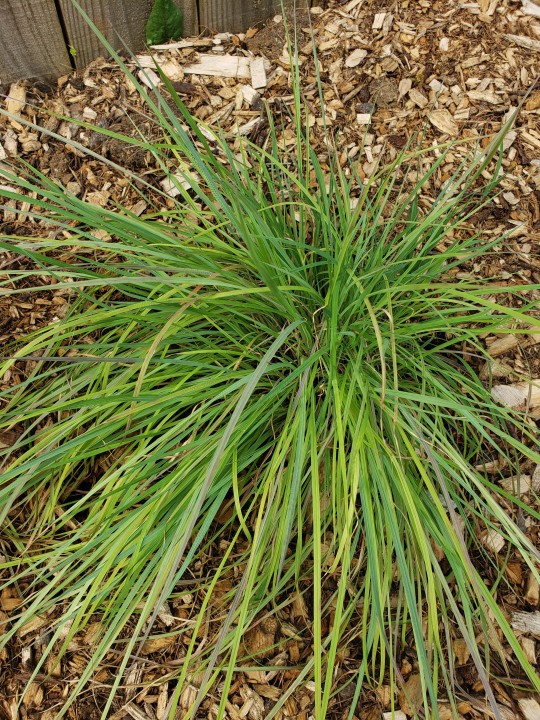

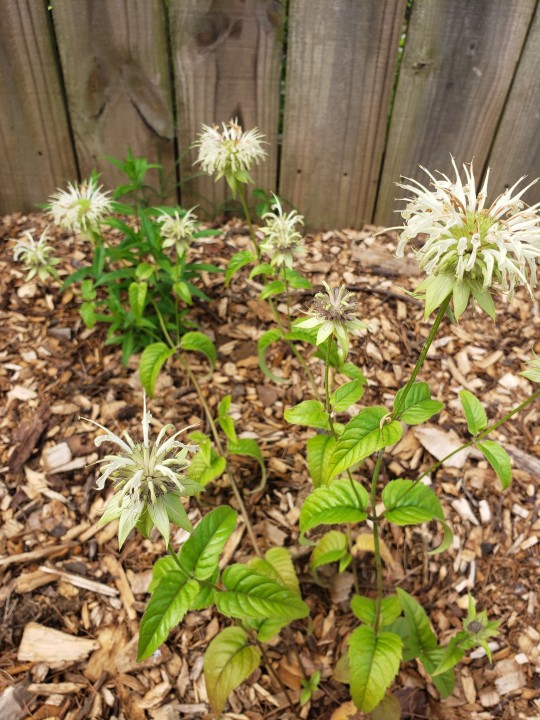
It felt like a race to plant this area. We dug a trench along the rock path, placed metal edging, planted, laid cardboard, and mulched. They get daily water from the sprinkler so everything did well while we were away. Everything is packed fairly tight, especially the blue indigo, but I'm hoping it will be ok. I blame alex, because he wanted it in that exact spot.
Plant list:
2x little bluestem
1x false blue indigo
1x monarda clinopodia
2x penstemon laevigatus
2x pink gaura
2x white gaura
2x blanketflower (i think gaillardia pulchella)
4x allium cernuum
1x fleabane of some sort
4x mountainmint (i think p. muticum)
2x phlox maculata
The bluestem is so colorful.
0 notes
Text
20 Things You Should Know About Yellow Bulb Flower | Yellow Bulb Flower
ENDVILLE • Thirty years ago, Martha Williams buried a row of about 50 ancient daylily bulbs she dug up from her mother’s yard. She acclimated a beanery to ball them because she didn’t accept a trowel.
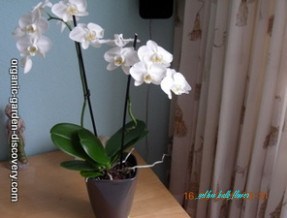
Flower Varieties List – yellow bulb flower | yellow bulb flower
Those aboriginal daylilies accept morphed into bags of blooms over the years and that’s aloof one bed of flowers. Williams has a dozen or added daylily beds about her home in Endville.
“I don’t accept any abstraction how abounding altered varieties I accept and I don’t apperceive the names of any of them,” said Williams, 86. “I aloof apperceive the colors. A lot of my blooms accept gone to red this year and I don’t apperceive why.”
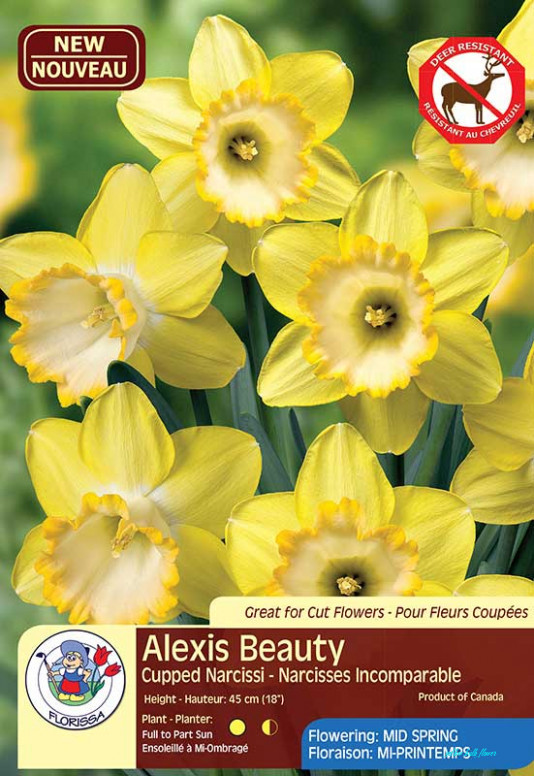
New for Fall 20: Deer Resistant Bulbs | Florissa Flowers – yellow bulb flower | yellow bulb flower
Some of Williams’ daylilies are buried forth a white blockade fence in advanced of her home while others are broadcast about walkways. Bloom colors accommodate red, purple, pink, peach, white, ablaze yellow, abysmal chicken and orange.
Five years afterwards her antecedent planting, Williams started attractive through annual catalogs and acquainted the daylilies they had for sale. She began visiting breadth in the breadth and alert to bodies allocution about growing daylilies.

Buy Erythronium Pagoda Bulbs Online : Cheap Spring Bulbs For Sale .. | yellow bulb flower
“The aboriginal ball I anytime bought amount me $3.50,” she said. “It was out of a garden in New Albany. I still accept that bulb. But I don’t buy abounding daylilies. Bodies are usually accommodating to accord you some.”
Williams said daylilies are decidedly low-maintenance flowers. She puts a 13-13-13 fertilizer about the flowers at atomic three times a year. Her flowers charge at atomic six hours of sunshine a day and she never amnion them.

Tiger Lily- Yellow, (20 Bulb/Plants) Gorgeous flowers – yellow bulb flower | yellow bulb flower
“I accept too much, too abounding to water,” she
20 Things You Should Know About Yellow Bulb Flower | Yellow Bulb Flower – yellow bulb flower
| Delightful in order to our weblog, with this period I’m going to show you concerning keyword. And now, this is actually the first picture:
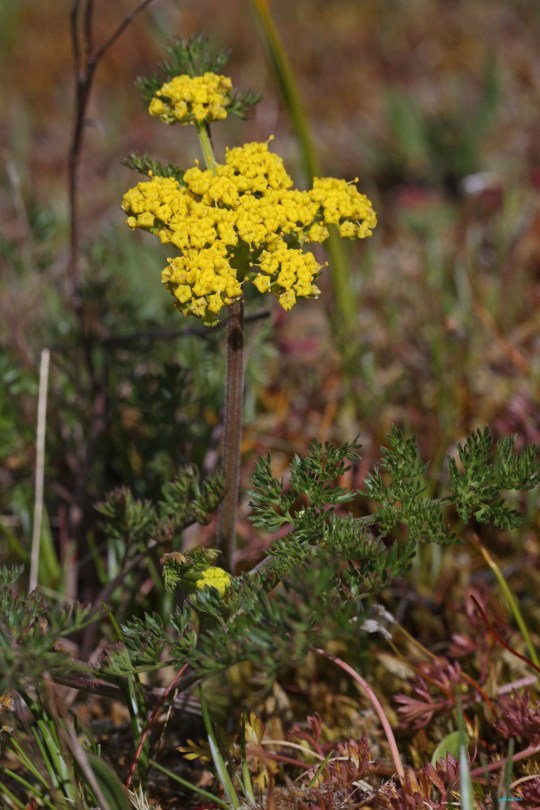
Lomatium – Wikipedia – yellow bulb flower | yellow bulb flower
Why not consider photograph above? is usually which amazing???. if you’re more dedicated so, I’l d provide you with several photograph once more beneath:
So, if you desire to receive these amazing graphics about (20 Things You Should Know About Yellow Bulb Flower | Yellow Bulb Flower), click on save link to store these pictures to your computer. There’re all set for obtain, if you appreciate and want to have it, click save badge in the article, and it will be instantly downloaded to your laptop.} Lastly if you want to obtain unique and the latest graphic related to (20 Things You Should Know About Yellow Bulb Flower | Yellow Bulb Flower), please follow us on google plus or bookmark this page, we try our best to present you daily update with fresh and new graphics. Hope you like keeping here. For most updates and recent information about (20 Things You Should Know About Yellow Bulb Flower | Yellow Bulb Flower) shots, please kindly follow us on tweets, path, Instagram and google plus, or you mark this page on book mark area, We attempt to offer you up-date periodically with fresh and new pics, love your browsing, and find the right for you.
Here you are at our site, articleabove (20 Things You Should Know About Yellow Bulb Flower | Yellow Bulb Flower) published . Today we’re pleased to declare that we have discovered an extremelyinteresting topicto be pointed out, namely (20 Things You Should Know About Yellow Bulb Flower | Yellow Bulb Flower) Many individuals searching for info about(20 Things You Should Know About Yellow Bulb Flower | Yellow Bulb Flower) and certainly one of these is you, is not it?
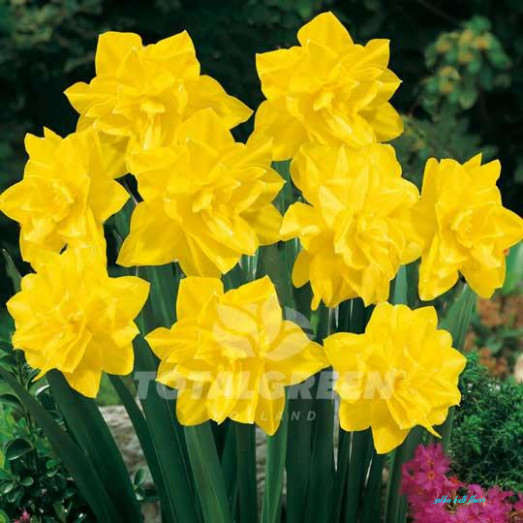
Daffodil Double Flowering Yellow – Plant Information – TotalGreen .. | yellow bulb flower

Trout Lilies | Children of the Spring | Garden Variety – yellow bulb flower | yellow bulb flower

Pacific Bulb Society | Favorite Yellow Flowered Bulbs – yellow bulb flower | yellow bulb flower
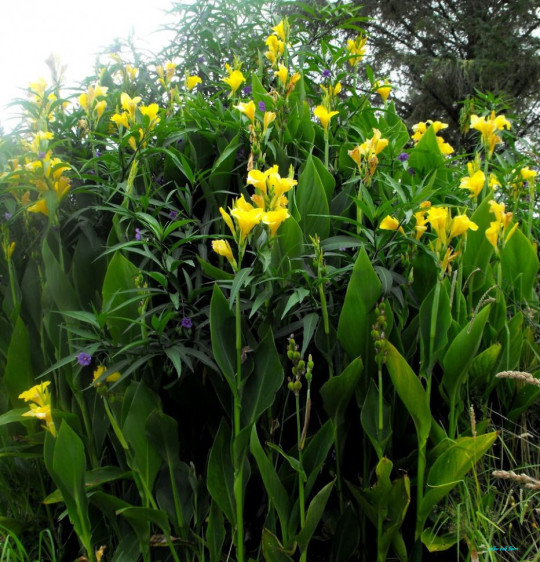
3 CANNA LILY Bulb sLARGE YELLOW FLOWERS Richard Wallace .. | yellow bulb flower

(20) Giant Flowering Yellow, Gold, Bananarama Gladiolus Bulbs ,Plant, Bulb, Root, Sword Lily, Gladioli – yellow bulb flower | yellow bulb flower

Yellow flower – yellow bulb flower | yellow bulb flower

Allium cernuum (Nodding Wild Onion): Minnesota Wildflowers – yellow bulb flower | yellow bulb flower

Yellow Mammoth Crocus Bulbs | Buy Crocus Bulbs in Bulk at .. | yellow bulb flower

NARCISSUS BULBOCODIUM GOLDEN BELLS A slightly taller, multi .. | yellow bulb flower
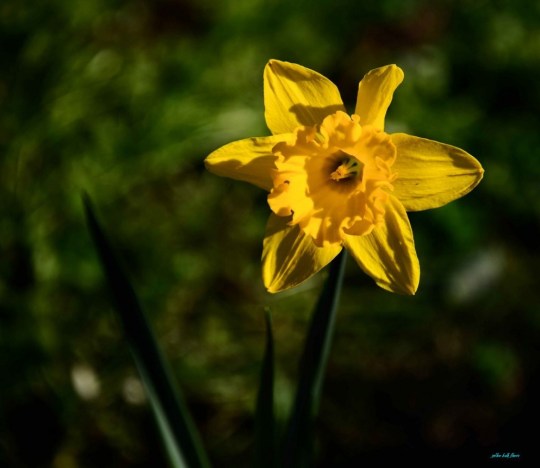
Daffodil day 25th August 2017 – yellow bulb flower | yellow bulb flower

Amazing and Beautiful Flowers Photos | Incredible Snaps – yellow bulb flower | yellow bulb flower

childanthus fragrans More Summer Flowering Bulbs Bulbs | Buy More .. | yellow bulb flower

After Bloom Care for Amaryllis – yellow bulb flower | yellow bulb flower
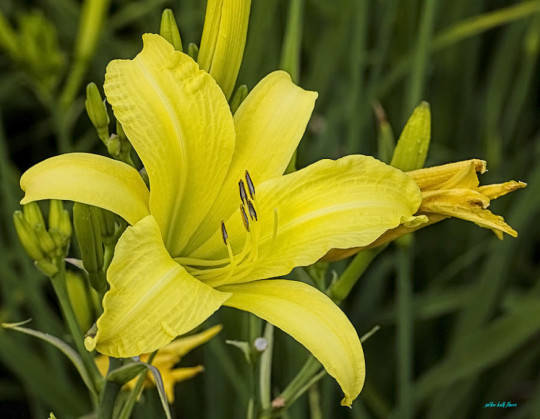
Day lily Yellow Hybrid flower bulbs pack of 20 – yellow bulb flower | yellow bulb flower

Calla Lily Yellow Bulbs – Flower Bulbs | Buy Online from .. | yellow bulb flower
from Wallpaper Nifty https://www.flowernifty.com/20-things-you-should-know-about-yellow-bulb-flower-yellow-bulb-flower/
0 notes
Photo
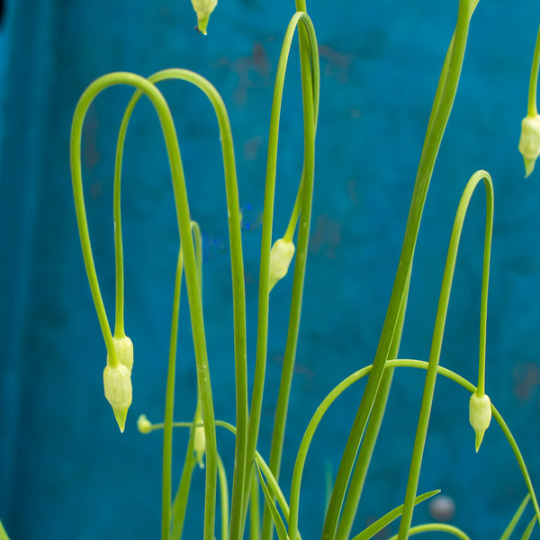



Nodding onion (Allium cernuum) has edible leaves and flowers (which are delicious) and bulbs (which I haven’t tried yet because I only have one plant).
More info on Plants for a Future.
Special note: keep in mind that Allium plants smell like onions or garlic. There are a number of lookalikes, some poisonous or even deadly, like the death camas, which has a very onion-like bulb and similar-looking flowers and leaves. If it doesn’t have an onion/garlic smell, it’s not an onion or garlic plant.
#native Ontario plant species with edible parts#flowering plants#flowers#edible plants#native north american species#plants I want#plants I have#nodding onion#Allium cernuum#garlic and onions#Canadian vegetables#dangerous lookalikes#death camas#Toxicoscordion venenosum
3 notes
·
View notes